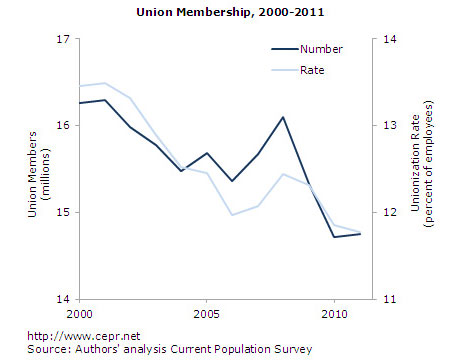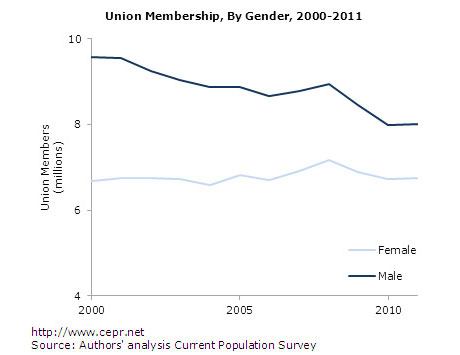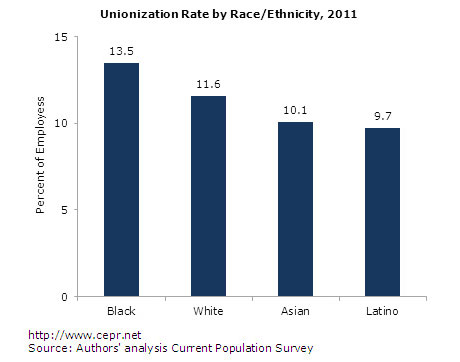
After falling by almost 1.4 million workers between 2008 and 2010, union membership hit a plateau in 2011. The total number of union members (up about 49,000) and the share of workers in a union (down 0.1 percentage points) were essentially unchanged last year.

In the public sector, the total number of union members declined 61,000, as squeezed federal, state, and local governments cut back employment. Union density (the share of the workforce that is a member of a union) in the public sector, however, increased 0.8 percentage points, to 37.0 percent. Density increased even as the number of union members dropped because overall employment in the sector declined more rapidly than union membership.
Meanwhile, in the private sector, union membership increased by about 110,000, with union density holding steady at 6.9 percent. Density remained unchanged between 2010 and 2011 because union employment increased at the same pace in 2011 as overall employment in the sector.
Overall, union density ticked down 0.1 percentage points, however, because employment shifted away from the more heavily unionized public sector and toward the less-heavily unionized private sector. For the third year in a row, public-sector workers made up a slight majority (51.2 percent) of all union workers.

The three broad industry categories with the largest net increases were health care and social assistance (up 101,000), construction (up 73,000), and durable manufactured goods (up 36,000). Professional and business services (down 65,000), utilities (down 36,000), and nondurable manufactured goods (down 31,000) were the industries with the biggest losses of union members.
Women continued to increase their representation in the union workforce. Of the 49,000-worker increase in union membership, about 36,000 were women and about 12,000 were men (the total does not sum to 49,000 due to rounding). As a result, the gender gap in unionization narrowed slightly from 1.5 percentage points in 2010 (a 12.6 percent unionization rate for men and an 11.1 percent rate for women) to 1.2 percentage points in 2011 (a 12.4 percent for men, 11.2 percent for women).

Unionization rates changed little by race in 2011. Black workers remained the most likely to be union members (13.5 percent, up 0.1 percentage points from 2010). White workers were the next most likely to be unionized (11.6 percent, a figure which includes Latinos following the Census methodology), essentially unchanged from 11.7 percent in 2010. Asians saw a decline in unionization rates to 10.1 percent (from 10.9 percent in 2010), but were still more likely to be unionized than Latino workers, at 9.7 percent.

Florida was the state experiencing the largest increase in union members in 2011 (up 68,000). Michigan was second (up 44,000) which translated to an increase of one full percentage point in the state's union density, from 16.5 percent in 2010 to 17.5 percent in 2011. Colorado (up 39,000), Illinois (up 32,000), and Missouri (up 31,000) also saw large increases in union membership.
Union membership fell sharply in New York (down 53,000) and California (down 52,000). New York remained the most heavily unionized state (24.1 percent), followed, as in 2010, by Alaska (22.1 percent). North Carolina (2.9 percent) and South Carolina (3.4 percent) were the states with the lowest share of union workers.
Our most important fundraising appeal of the year
December is the most critical time of year for Truthout, because our nonprofit news is funded almost entirely by individual donations from readers like you. So before you navigate away, we ask that you take just a second to support Truthout with a tax-deductible donation.
This year is a little different. We are up against a far-reaching, wide-scale attack on press freedom coming from the Trump administration. 2025 was a year of frightening censorship, news industry corporate consolidation, and worsening financial conditions for progressive nonprofits across the board.
We can only resist Trump’s agenda by cultivating a strong base of support. The right-wing mediasphere is funded comfortably by billionaire owners and venture capitalist philanthropists. At Truthout, we have you.
We’ve set an ambitious target for our year-end campaign — a goal of $180,000 to keep up our fight against authoritarianism in 2026. Please take a meaningful action in this fight: make a one-time or monthly donation to Truthout before December 31. If you have the means, please dig deep.